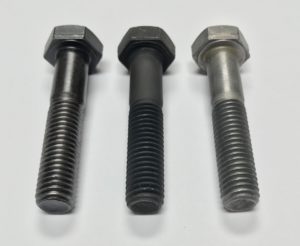Technical & Safety Data
Log in or sign up to access technical data, safety data, applicator approvals and troubleshooting guides.

Columbia Chemical’s Matt Schario says focus on the acid pickling stage of the plating process to solve adhesion issues on high-carbon steel.
Products Finishing
Expert Clinic/Plating
Matt Schario, Director of Technical Service ~ Columbia Chemical
Q. We process a large variety of part types, and lately we have been having adhesion issues when plating our high-carbon, heat-treated fasteners. What can we do to alleviate this problem?
A. Adhesion issues can be common on high-carbon, heat-treated steel, and one of the primary areas on which to focus when addressing this issue is the acid pickling stage of the process. High-carbon steel generally can be classified as an iron-carbon alloy, ranging from 0.55 to 1.40 percent carbon. High-carbon steel is harder and stronger than regular mild steel, and it is often heat-treated to improve properties such as impact resistance, hardness, ductility and various others, depending on the type of heat treatment. The resulting makeup of the substrate has a direct bearing on the acid pickle performance.
The goal of the acid pickle is to remove the scale and metal oxides that generally form on the surface of the metal during the heat-treatment process. The oxide layer is “attacked” by the acid pickle solution, producing a metallic salt and water mixture. A problem arises if the entire oxide layer is removed, however, because then base metal would begin to dissolve, producing a metal salt that liberates hydrogen in the acid pickle. This is where the true challenge lies in plating heat-treated, high-carbon fasteners. It often takes higher concentrations of hydrochloric acid or alternatives such as ammonium bi-fluoride to appropriately remove the metal-oxide scale or smut. If the oxide layer is entirely removed and the base steel is attacked, the dissolution of the steel substrate creates a carbon-rich surface. The adhesion issues you mention are due to the inability to initiate plating over top of this carbon-rich surface. Furthermore, the liberation of hydrogen can also cause issues with hydrogen embrittlement, a major concern in the fastener industry.
The unique makeup and requirements of high-carbon, heat-treated fasteners present an extremely challenging scenario to strike the perfect balance between over- and under-pickling. The most common fix for this problem is the implementation of an acid pickle inhibitor. Acid pickle inhibitors work by creating a protective film through methods of adsorption, which protects the steel substrate but allows the oxide layer to be dissolved regularly. The photo on this page shows, from left to right, a typical 10.9 bolt as is, the same bolt after pickling with no inhibitor and finally the bolt after pickling using an acid inhibitor. The as-is bolt gives a fair representation of a heat-treated fastener and the amount of heat-treated scale present. The bolt after pickling with no inhibitor demonstrates the effect of a typical pretreatment cycle: it is extremely black and smutty due to the resulting carbon-rich surface. Finally, the bolt with the acid inhibitor is a perfect gun-metal grey, because the metal oxide layer was dissolved but the substrate was left unaffected. This led to the bolt being plated effectively.
Acid pickle inhibitors offer a myriad of benefits in many different plating applications. Specifically, with regard to high-carbon, heat-treated steel, they are designed to inhibit the attack of the steel substrate but allow the speed at which they remove scale or other compounds to remain similar. This permits the substrate to stay relatively unaltered by the acid pickling while still maintaining the necessary cleaning functions of the pickling process. In addition, the acid pickle life is generally extended, because less metal is being dissolved into the pickle solution, reducing drag-down of any metallic contamination. Acid pickle inhibitors also often contain other types of surfactants that help build a foam blanket designed to reduce acidic misting in the workplace.
So, as we’ve outlined here, adhesion issues with high-carbon, heat-treated fasteners are often due to parts coming out of the pickle process with a carbon-rich surface as a result of the base steel being attacked. Careful attention to the acid pickling stage of the process and the addition of an acid pickle inhibitor may help alleviate this problem. Recent developments in acid pickle inhibitors have also reduced excessive film formation or hard-to-remove substances that were prevalent in older-generation inhibitors causing staining and blistering issues. It is worth noting, however, that not all acid inhibitors are created equal, and they may not work on the same substrate in the same manner, so it is important to rely on a trusted chemical supplier to address specific applications or questions.

This photo shows, from left to right, a typical 10.9 bolt as is, the same bolt after pickling with no inhibitor and finally the bolt after pickling using an acid inhibitor.
This article was published in the January 2018 issue of Products Finishing magazine.